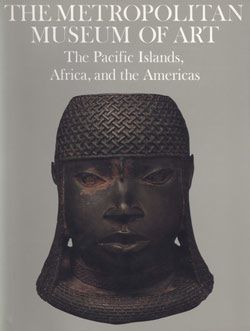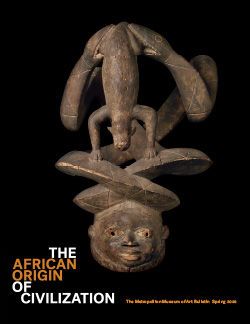Ceremonial Ladle (Wakemia or Wunkirmian)
Artists in Dan communities of Liberia and Côte d’Ivoire have mastered the art of carving impressive wooden ladles that are virtuoso works of sculpture. These ceremonial ladles, known as wunkirmian or wakemia (which translates as "spoon associated with feasts") are badges of prestige acknowledging an individual woman for her incomparable generosity. Oversized (they can measure up to two feet), they are not so much utilitarian objects as symbols of status and the bearer of spiritual powers. Quality of craftsmanship and complexity of design are constitutive of the work’s importance.
To create such esteemed objects, Dan sculptors often rely on anthropomorphic forms and draw upon elements of style developed in other carvings such as masks and figures. This arresting example presents a wonderful abstraction of the human form: its handle depicts the lower half of a female body while its bowl symbolically replaces the body’s upper part. Here, the artist has combined anatomical preciseness with stylization that draws attention to certain idealized bodily attributes. The handle’s solid, rounded forms suggest vigor and productiveness. The robust calves attest to the ability to work hard and give the impression of youth. Youth is associated with the notion of fertility, a significant cultural ideal. The carver has represented the legs slightly spread apart and bent, adding dynamism to the composition. Similarly, the feet are delicately extended at different angles, suggesting movement. Circular disks accentuate the position of the knees repeating curvilinear forms. The intricacy of the work and the sculptor's attention to detail is evident in the articulated toes and the embellishments of beautifying markings on the surface of the slender thighs. Both the smooth concave surface and the hatched convex side recall images of luminous adorned skin. At the center of the ladle, a fluted narrow form links handle to bowl and allows for a harmonious transition between two contrasting elements.
Depiction of legs are not the most common anthropomorphic feature carved as a ladle’s handle: more frequent are handles representing the likeness of a human head (such as the other example of Dan wunkirmian in the Met’s collection, 1979.206.254). Other variations include representations of a human hand, animal heads such as goats or cow, small bowls, and a variety of abstract designs. According to paramount chief Woto Mongru of Kanple interviewed by Barbara Johnson in 1983, legs, when chosen to be featured as the ladle’s handle, represent all the people arriving on foot to be fed by its owner (Johnson 1987, 20); the bowl, rounded and lustrous, symbolizes the womb of the ladle's spirit 'pregnant' with rice.
Emblematic of honor and status, wunkirmian are the possession of the wunkirle or wakede, "at feasts acting woman." A title of great distinction, it is given to the most hospitable woman of a village quarter. German art historian Hans Himmelheber, together with Wowoa Tame-Tabmen, has best described the role of the wunkirle in an article dedicated to the topic (Himmelheber and Tabmen 1965). One woman in each village quarter is honored with the title of wunkirle. When a wunkirle becomes old she chooses her successor from among the young women of her quarter (Johnson 1987, 17) and passes down her wunkirmian. With the honor comes a lot of responsibility— the wunkirle must be of a generous disposition, gladly offering her hospitality to anyone at any time, organizing and providing for important meals, and feeding travelers. In order to be able to afford this largess, the wunkirle must be successful and industrious, and a well accomplished farmer.
In addition to being emblems of honor, wunkirmian also hold spiritual power (Himmelheber and Tabmen 1965, 177). They are a Dan woman's chief liaison with the power of the spirit world and a symbol of that connection. In the words of a wunkirle, Doa, the ladles contain "all the power and fame of the wunkirle" (Johnson 1987, 19). Among the Dan, the wunkirmian have been assigned a role among women that is comparable to that which masks serve among the men. As are masks, each wunkirmian is given an individual name. When a new wunkirmian is carved to replace an old one, sacrifices are made to empower it. In many instances, wunkirmian are featured in the same ceremonies with masks, tossing rice in front of them as a blessing while they proceed through the village.
In that context, one of the wunkirle’s responsibilities is preparing the large feast that accompanies masquerade ceremonies. The excellent farming abilities, organizational talents, and culinary skills of the wunkirle are called upon to properly welcome and celebrate the masquerade spirits. When a woman has been selected as the main hostess of such a feast, she parades through town carrying the large ladle as an emblem of her status. She is followed by a line of women from her quarter, each carrying a pot of cooked rice or soup. With help from her numerous assistants (usually female relatives or friends), she distributes grains and coins to the children of the community while dancing and singing. The event creates a profound visual analogy that honors the hostess, and women in general, as a source of food and life.
In 1926, a young Alberto Giacometti (1901-1966) reinterpreted the Dan equation between a woman’s womb and the bowl of a spoon in his sculpture Spoon Woman (Femme Cuillère). Like many artists of his generation, he was familiar with and admired the bold reinterpretations of the human body imagined and expressed by artists from West and Central Africa that had begun to fill the Parisian artists’ ateliers during the first decade of the 20th century. In this life-size bronze sculpture, considered among his earliest mature works, the artist uses the premise established by Dan carvers as a point of departure, but pushes the form further towards geometric abstraction.
Yaëlle Biro, 2016
Further reading
Fischer, E. and H. Himmelheber. 1984. The Arts of the Dan in West Africa. Zurich: Museum Rietberg.
Fischer, E. and H. Himmelheber. 1991. "Spoons of the Dan (Liberia/Ivory Coast)." Looking-Serving-Eating-Emblems of Abundance. Homberger, L., ed. Zurich: Museum Rietberg.
Fischer, E. and L. Homberger. 2014. Afrikanische Meister: Kunst der Elfenbeinküste.
Himmelheber, H. and Wowoa Tame-Tabmen. "Wunkirle, die gastlichste Frau." In Festschrift Alfred Bühler, ed. Carl M. Schmitz. Basel: Pharos Verlag, 1965, pp. 171-181.
Johnson, B.C. 1984. Seeking a Name: Four Dan Sculptors of Liberia. San Francisco: San Francisco State University.
Johnson, B.C. 1987. Four Dan Sculptors: Continuity and Change. San Francisco: San Francisco State University.
Winizki, E. Afrikanische Loffel: African Spoons. Zurich: Museum Rietberg.
Due to rights restrictions, this image cannot be enlarged, viewed at full screen, or downloaded.
This artwork is meant to be viewed from right to left. Scroll left to view more.







